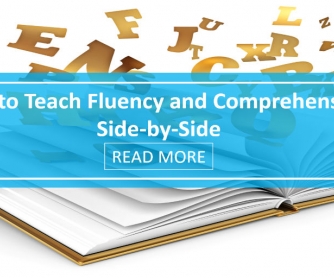
As teachers, we strive to create strong readers. We want students who can read a text aloud accurately and with appropriate expression. Sometimes, however, the development of fluency comes at the cost of comprehension. Students focus so much on forming words, inflecting their voice, and following what's on the page that they don't stop to actually think about what they're reading. Successful reading instruction teaches comprehension alongside fluency to create truly strong readers.
What is Fluency?
Fluency is the ability to read a text accurately at an appropriate speed. It also involves using appropriate expression or inflection while reading words aloud. You can tell a fluent reader by how smoothly the words sound when read aloud. A reader who has not developed fluency may sound more choppy, stumble over words, and read in a more monotone voice.
When it comes to teaching fluency, many teachers assess students' speed and accuracy, but the key component of fluency that connects to comprehension is the reader's expression or inflection, also known as prosody.
Look at the text below:
It was a beautiful day outside. The sun was shining. The birds were chirping. Children were running and playing.
"Today is a wonderful day," Milo said.
"What's so wonderful about it?" Mia replied with a frown on her face.
Read the text aloud. Think about what words you emphasize and how you show comprehension of the text as you read. Maybe you read the first few sentences with a wistful tone. Perhaps you use a snippy tone as you read Mia's question. These elements are where fluency connects to comprehension.
What is Comprehension?
Comprehension is the ability to understand and interpret a piece of text. This includes not just describing what the text was about, but also thinking deeply about the content of the text and connecting it to other areas. Often when teachers teach comprehension, they focus on the basic Who? What? Where? When? Why? and How?, but comprehension actually goes beyond that to ask "Why is this text important?" and "How can I connect it to myself, other texts I've read, and the world around me?"
Connecting Comprehension and Fluency
In order to help students become the best they can be, it's important to teach comprehension and fluency hand in hand. In the early grades, rather than simply testing a student's speed and accuracy or listening to see how well a student reads a text, teachers should offer a more integrated approach. As students get older and exprerience more difficult texts, the focus shifts away from fluency and focuses more on comprehension, but teachers should still model strong fluency skills to help students continue to build key word recognition and comprehension skills.
Teachers can use the following strategies to ensure they're teaching both fluency and comprehension in the classroom.
Preview a Text
Before reading any text, take time to preview it. Look at the title, the name of the author, the layout, and any illustrations that appear. This helps give the reader a frame of mind before reading the text. Often these features can provide clues to help readers decode more difficult words in a text.
For example, if a student is reading a book about dinosaurs, he or she may have heard the word "jurassic" but never seen it in print. If the student previews the book, when he or she encounters the new word and tries to sound it out, the brain will say, "Hey, this sounds like the word 'jurassic' which I heard on a show about dinosaurs."
Illustrations can also help with fluency and comprehension. In a picture book, a reader may notice the words he or she is reading do not seem to match the picture on the page. This could be a sign that the reader is not reading the correct words or that the reader is not fully understanding the text. The picture may propmpt the reader to go back and try again or ask a question to let the teacher know something is wrong.
Talk to the Text
Teach readers to talk to the text as they read. Practice making predictions and asking questions as they read. You can model this for students when you read aloud. Talking to a text may slow down a student's speed, but it can improve accuracy and it will definitely improve comprehension because a reader will stop and think, "What is the text actually saying?" and "What is going to happen next?"
Teach Vocabulary
Going beyond spelling and pronunciation and actually teaching vocabulary, especially in upper elementary school and beyond, will go a long way towards helping fluency and comprehension. For example, a student may be able to read the word "desert," but does the student use the correct pronunciation in the context? There's a big difference between "We're lost in the desert" and "I'm going to desert you."
Teach Word Parts
Along with vocabulary, word parts can help students with fluency and pronounciation. When students learn prefixes, suffixes, and word roots, they not only learn how to pronounce key components of words, they also learn how those components change a word's meaning. At earlier levels, teaching word parts helps students know that "hoping" and "hopping" have different pronunciations, but they also learn that "-ing" represents an action or a gerund.
Model Good Reading
Have you ever heard a reader who really makes a text come alive? If you haven't, look up a children's storyteller such as Bill Harley. It's so much easier to understand a story when it's read well. As students read silently, play an engaging audio recording of a story or read aloud to them. Don't just do this in elementary school - older students need to be read aloud to occasionally too.
Stop and Check Comprehension
Whenever you read something in class, stop occasionally and ask, "What does that mean?" or "What did the text just say?" This is especially important as students read more difficult texts. For example, when students read Shakespeare, they freqeuntly pronounce the words well, but when you stop to ask them what they just read, they don't have a clue. The same can be true of a highly scientific text where students know the words, but don't really understand the content. By stopping to check comprehension, you can see whether students are actually understanding what they're reading or just have strong speed and accuracy.
Read
Most importantly, get students to read often. Help them choose texts appropriate to their interests and reading level. The more students expose themselves to reading, the better chance they have of developing stronger reading and comprehension skills. Don't focus so much on grading students or having them complete assignments related to books. Instead, make reading something more fun and enjoyable by simply talking about what they're reading and giving them a chance to read to you.
P.S. If you enjoyed this article, please help spread it by clicking one of those sharing buttons below. And if you are interested in more, you should follow our Facebook page where we share more about creative, non-boring ways to teach English.








